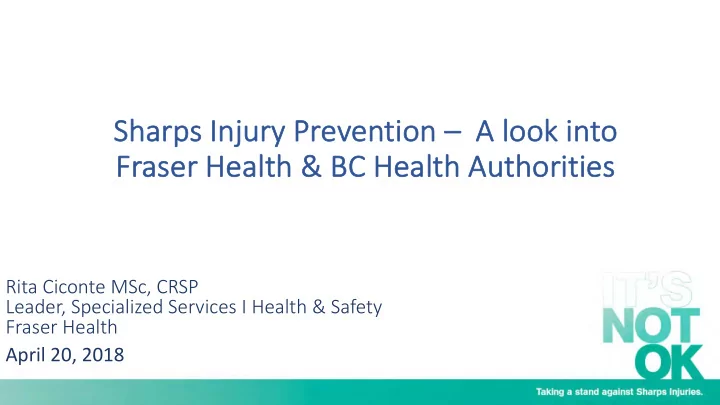

Sh Sharp rps Injury Prevention on – A A look into Fr Fras aser er Health Health & BC Health Health Autho uthorities ities Rita Ciconte MSc, CRSP Leader, Specialized Services I Health & Safety Fraser Health April 20, 2018
• BC Healthcare – How we’re organized • Fraser Health - who we are, what we did, how we’re doing • WorkSafe BC Regulation Lessons Learned, Challenges and the Future •
BC Healthcare – how are we organized BC Health Authorities q Provincial Health Services Authority (province wide) First Nations Health Authority q
Sharps Injury Prevention - Initial Effort 2004 Blood and Body Fluid (BBF) Exposure Control Program developed • Multi-disciplinary group involved in product selection • Safety Engineered Medical Devices (SEMDs) introduced mid-2004 • Hypodermic needles IV Catheters BD Insyte Autoguard BD SafetyGlide BD SafetyGlide TNT BD Eclipse BD Saf-T-Intima
Sharps Injury Prevention - Initial Effort Change management challenges encountered: Inventory Coordination issues 1. Resistance to technique changes 2. Hoarding of conventional devices 3.
Sharps Injury Prevention - Initial Effort Safe Needle Task Group: Occupational Health and • authority-wide action plan for re-implementation Safety • included site leadership & educators Purchasing Clinical • corporate policy Contracts Products Coordinator Coordinator
Department and Site drop-in Education sessions conducted by Manufacturer Reps
Conducted department supply reviews: • Address hoarding of conventional devices • Re-educate on products options & uses • Report compliance to Organizational Leadership
Initial Implementation – Results Rate of Sharps Injuries per 100 FTE 4.5 Incident Rate per 100 FTE 4.0 Incident Rate per 100 FTE 3.5 3.0 2.5 2.0 1.5 1.0 0.5 0.0 2003 (Pre) 2006 (Post) 2003 (pre) 2006 (post) Period Period
Initial Implementation Outcomes • Overall sharps injury rate decreased • Medical and surgical wards converted to safety sharps • Incomplete conversions in: ORs, ER, Ambulatory Care, Labour & Delivery • Most areas with limited implementation saw little to no improvement in rates
WorkSafe BC Regulation (2008…) • January 1st, 2008 OHSR requires use of safety engineered hollow bore needles • October 1st, 2008, further changes to the OHSR • require the use of safety engineered devices for all medical sharps • Only devices that have built in safety features or mechanisms that eliminate or minimize the risk of accidental parenteral contact can be used • Where there is a choice between more than one type of safety engineered sharp , the device that offers highest level of protection from exposure to blood borne pathogens must be used . Defined two instances where conventional sharps could still be used: 1. The use of the safety device is not clinically appropriate, and 2. A safety device is not available on commercial markets in Canada.
Fraser Health – other BBF Prevention Initiatives • Regional working groups created • Evolved into Lab and Surgical BBF working groups • Neutral Zone Policy, 2008 • Champions Initiative 2010 • disposable scalpels implementation • Target projects • ER, Labs, Surgical Units, Medical Units, ORs
Fraser Health – other BBF Prevention Initiatives • Focus groups • Department audits and worker surveys • Roll-out of online learning modules • Post-secondary institution partnerships • Lab SEMD implementation • BC SEMD Activation Study • Facility design to ensure appropriate sharps container installation
What does the data show?
Fraser Health – Injury Rates overtime Fraser Health Incident rate / 100 FTE 2.50 2.14 1.99 2.00 1.74 1.56 - excludes physicians 1.50 1.28 1.00 0.50 0.00 2013 2014 2015 2016 2017
Fraser Health – Timing of Sharps Injuries Jan 1, 2016 – Dec 31 2017 • 507 injuries reported • All Health Authority with the exception of: • Medical Device Reprocessing • Facilities Maintenance • Pharmacy • Lab • Medical Imaging • Biomedical Engineering
Jan 1/16 – Dec 31/17 • 96 reported Injuries
53 reported incidents • Across 12 sites
Rate per 100 FTE BC Health Authority - Acute Care 3.00 Averaged over 2013 – 2017 2.53 2.50 2.05 1.94 2.00 1.79 1.71 1.69 1.64 1.50 1.00 0.50 - FHA IHA NHA PHC PHSA VCH VIHA
Rate Per 100 FTE for All BC Health Authorities Acute Care by Year 2.02 1.99 2.00 1.89 1.74 1.68 1.50 1.00 0.50 - 2013 2014 2015 2016 2017
Reported Sharps Injury for All BC Health Authorities Acute Care by Occupation (2013 - 2017) Resident, 7% Laboratory Worker, 11% 329 517 Medical Device Reprocessing Tech, 5% 242 N = 4797 Nurse, 68% 3295
Percent Incidenty for All BC Health Authority Acute by Device Type Winged steel/butterfly needle, Blade, 2% 5% Scalpel Disposable, 3% Suture Needle, 5% Hypodermic/straight needle, Scalpel Reusable 23% 1% Insulin Pen, 4% IV catheter stylet, 4% Other Lancet, 1% Unknown, 7%
BC Healthcare OHS Systems • Injury reports called into Provincial Workplace Health Call Centre • Use standardized tracking database • Provincial OHS Working Group – established SEMD clinical purchasing criteria
Lessons Learned • Task group should be involved from inception • Policy with Executive approval needed • Recommend developing a system for approving clinical variances prior to onset • Coordinate SEMDs education & device access • Conducting department supply reviews is beneficial • Accurate injury tracking & coding crucial - Power in standardized reporting sys • Many staff appreciate the safety alternatives
Challenges • Inconsistent Canadian regulations affected purchasing contracts & product access • Lack of clinically acceptable reusable safety scalpels • Insulin needles versus Insulin pens • Purchasing contract extensions • National purchasing contracts scoring without hands-on evaluation • Lack of ongoing evaluations to ensure “safest” devices are in place • Passive (if clinically appropriate) considered higher level of safety
• Provincial/national contract process underway • Product Trials to consider - “levels of safety” active versus passive • Some SEMD changes have proven HCW + patient safety benefits • Continue to review new products • Need more evidence based research on outcomes of product trials
Thank-you Rita.Ciconte@fraserhealth.ca
Recommend
More recommend